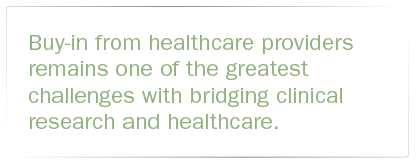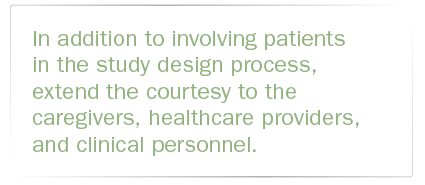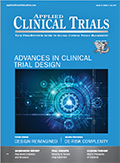Clinical Research as a Care Option: Optimizing Approaches
Applied Clinical Trials
Examining the fundamental changes required to successfully integrate clinical research into mainstream healthcare.

The recent industry-wide focus on expanded access to healthcare as well as the desire for patient-centric approaches, high-quality care, and enhanced patient satisfaction have increased the interest in the concept of clinical research as a care option (CRAACO). The CRAACO concept views clinical trial participation as another viable medical care option for all patients who qualify, ultimately improving patient and population health while simultaneously accelerating clinical research.
The benefits of CRAACO include improved patient access, expedited drug development, and improved patient outcomes. To realize these benefits, a fundamental change in healthcare systems needs to occur-going beyond just increasing individual and physician awareness of clinical trials as a valid care option to integrating CRAACO into the healthcare ecosystem. Only then can we seize the opportunity to utilize CRAACO to help address our collective responsibility of changing the reality of health disparities and access to care. In this article, three key considerations and strategies for helping theconcept of CRAACO succeed are discussed.
How can the industry realize the benefits of CRAACO?
We have yet to see the broad integration of CRAACO in healthcare for a number of reasons, including: a general lack of awareness of clinical trials; a lack of knowledge of the currently available clinical trials; a perception that clinical trials are burdensome and do not consider the patient’s best interest; the belief that trials do not cater to participants’ individual needs; and ethical concerns within the industry about confusing research with patient care.
To overcome these challenges, the industry needs to build awareness and trust across the entire spectrum of care, begin considering patients as individual people, and focus on people (versus patient) centricity.
1. Closing the awareness gap and building trust
For patients and physicians alike, the lack of an integrated approach to research across the healthcare system limits awareness of clinical trials.1 When surveyed, 45%-58% of patient respondents around the world said their doctors did not offer research as a care option.2,3 Physicians and nurses report not referring patients to clinical trials because they are unable to access clinical study information, are unsure of the referral process, and have insufficient time and information to evaluate clinical trials, let alone discuss them with their patients.4
Regarding trust, hesitancy about taking a chance with their health, concerns about the risks of clinical research, and the desire to avoid being treated as a “guinea pig” ranked as the top three reasons why patients do not participate in research.2,3 Some members of the public also remain concerned that patients are enrolled in trials without their knowledge, and a third of survey respondents believed that participants in clinical trials are not treated fairly and with respect.5
Strategies for building awareness and trust
It might be time to reconsider how we communicate with patients about trials. Awareness efforts should focus on sources patients regularly use and in which they place the greatest amount of trust. The best approach needs to be determined for each study-based on the patient population, geographic location, and therapeutic area.
Digital media has become a leading source of health information, with 80% of individuals using online sources to learn more about specific diseases or treatments.6 Regarding clinical trial information, 57% of patients would search online, compared with 60% who reported they would ask their doctor.5 To access information digitally, mobile devices are increasingly the go-to platform, which can also be leveraged by sponsors to easily determine eligibility even while the patient is still at their doctor’s office.6
Although digital sources are the most widely preferred globally, preferences do vary by patient demographic and specific geographic location.2 For example, compared with respondents in North America, Europe, and Asia-Pacific, respondents in South America were more likely to become aware of clinical trials through pharma company websites or their family and friends. Along with TV and newspaper ads, these sources represented the top three rankings.
Similarly, the level of trust placed in information sources varies. In a recent survey of previous trial participants, TV or newspaper ads are the least trusted source globally.2 Interestingly, when segmented by sociodemographic characteristics, respondents with lower education levels placed the greatest trust in TV or newspaper ads, while Hispanic respondents placed the least trust in clinical research information found in doctor’s offices or clinics.
To overcome some of the trust issues, consider involving the target population in the study design process. Provide information up front about the study objectives, ask for insights regarding the outcomes of most importance to them, and make sure that the insights gained through the research (e.g., lab tests, study results) are used for ongoing patient benefit. In essence, make sure that the patients are also benefiting from the research.7 Also, seek input regarding how study participation could be facilitated (e.g., visit scheduling, visit locations, data collection modality).
An overwhelming 72% of patients would participate in clinical research if their doctor recommended it,5 and more than half of all respondents, regardless of geographic location, age, education level, or socioeconomic status, preferred

hearing about trials from their healthcare provider more than from anywhere else.2,3 Although many doctors and nurses are willing to consider clinical research in their practice, currently they only refer 0.04%-0.2% of their patients to clinical trials.4 Buy-in from healthcare providers remains one of the greatest challenges with bridging clinical research and healthcare,8 highlighting the importance of increasing outreach to physicians and healthcare providers.
It is crucial to implement strategies to help these parties find and identify well-designed trials. Perhaps use regularly visited web-based platforms such as specific healthcare social media platforms or reference sites, in which information can be conveniently and quickly reviewed and processed. Educational programs and continual training about clinical trial offerings could be provided across all areas of care and specialties.
By adapting an integrated, consistent approach to research within the ecosystem, companies could start to build trust that the process of referring and following up patients in clinical trials will not substantially increase the burden of care.
2. Recognizing patients as individuals
Clinical trials have traditionally viewed the target population as a disease or condition of interest, rather than as unique individuals with different concerns, lifestyles, and level of healthcare management.
Strategies to make patients feel like valued individuals
As with the strategies to increase awareness, it’s time to go “where the patients are”-understand what motivates and limits research participation and build strategies around these. Also, be aware that these motivators and limitations (both perceived and real) could differ from study to study, depending on the target population and therapeutic area, and the incentives to participate should be commensurate to the level of burden.
Many patients and caregivers appreciate that efforts are being spent to find new treatments but may need more than an altruistic motive for participation. For more debilitating, progressive, and degenerative diseases, patients’ capabilities can change over time, making daily commitments burdensome. Home visits, virtual studies, or hybrid studies could overcome the limited participation and patient under-representation that can result from the use of traditional brick and mortar research sites.6
While technology can broaden the patient reach, consideration of the right technology for the target population must also be given-factors such as text visibility, button size, data requirements, and language.
Again, patient involvement in the study design process could help identify the best strategies to encourage participation and make the research more valuable to individual patients. Patient insight regarding the outcomes that are important to them-such as symptom management for better quality of life-could inform secondary outcome measures. Treatment design can be enhanced by patients’ subjective reporting of symptoms and side effects. Digital apps can be particularly useful for this purpose, allowing tracking in real-time and prompting to remind patients to enter data.
3. Shifting toward people centricity
Patients do not exist on their own. They are often surrounded by a support group-caregivers, clinical professionals, healthcare providers, and family members. Broadening our view of “patient centricity” to “people centricity” recognizes each person’s unique support system, ultimately driving patient centricity.
Strategies to achieve people centricity
Consider the approach to CRAACO as a collaborative approach. In addition to involving patients in the study design process, extend the courtesy to the caregivers, healthcare providers, and clinical personnel. Determine what outcomes are important to them and how the study could be designed to fit within their lives.

Caregivers might place value on home-based visits rather than clinic visits, reducing the burden of participation. Similarly, if caregivers will be tasked with data collection, determine what mode, timing, and frequency would interfere the least with the caregiving and their daily lives.
One big concern for healthcare providers is the time required to match the right patient to the right clinical trial and then explain the trial to the patient in an already busy day. It is important to create an environment in which clinical trial activities and resources are shared across the hospital or health center. Implement high-quality, standardized processes for education about clinical trial offerings and how to present that information to patients. Consider incorporating a research team or patient liaisons to educate patients and bridge healthcare with clinical research.
Yet another option is online, digital recruitment products that can be accessed by the patient in the clinic, provide a trial overview, and determine clinical study eligibility on the spot.
Ethical considerations
Some believe that the CRAACO concept can help the industry meet its ethical responsibility to provide the best care to patients and close the gap in healthcare access through innovation. To achieve this, those in the industry need to reject the idea that change is necessarily slow, and instead create an environment that embraces new ideas and solutions-essentially, “a clinical culture where innovation is not viewed as the domain of the few, but as the responsibility of many.”9
Simultaneously, others feel that industry needs to help society avoid “therapeutic misconception”-namely that clinical trial participation is confused with receiving medical benefits.10 This stems from current regulations, which outline that informed consent processes are required to clearly explain that patients are participating in research, not treatment.
Given that many individuals expect some direct benefit from clinical research, and to meet the industry’s due diligence for patient care, life sciences companies need to revisit their definitions of care vs clinical research. The industry also should extend this conversation to consider what happens when a treatment works for some individuals but the overall clinical trial is not successful. Should treatment continue?
It is encouraging to see these and similar topics being discussed by the industry as a whole at conferences such as Clinical Research as a Care Option (CRAACO) 2019, held in April in North Carolina. With these conversations, the industry can begin to make progress in its understanding and implementation of CRAACO.
An opportunity to expand healthcare access
CRAACO represents an opportunity for a collaborative approach to healthcare between patients, healthcare providers, healthcare systems, drug developers, and policymakers, ultimately bringing drugs to market faster and improving patient outcomes. The evolution will not occur overnight, because it requires fundamental changes in the integration of clinical research into mainstream healthcare as well as a shift toward a holistic patient view. However, through collective efforts, the industry has the capacity to connect innovative developments with the reality of care-and move closer to an approach that truly has the patient at the core.
References
- Shen J, Buechler A, Byrne J, et al. “Clinical research participation as a care option: driving patient experience and satisfaction.” PMG Research whitepaper. https://www.pmg-research.com/Portals/0/Clinical%20Research%20as%20a%20Care%20Option_PMG%20Research%20White%20Paper%20Web2.pdf
- The Center for Information & Study on Clinical Research Participation. “Report on the decision to participate: 2015 perceptions & insight study.” 2015. https://www.ciscrp.org/download/2015-perceptions-insights-study-decision-to-participate/?wpdmdl=5734
- Anderson A, Borfitz D, Getz K. “Global public attitudes about clinical research and patient experiences with clinical trials.” JAMA Network Open. 2018;1(6):e182969
- Getz K. “Examining and enabling the role of healthcare providers as patient engagement facilitators in clinical trials.” Clinical Therapeutics. 2017;39(11):2203-2213
- Research!America. “Poll: majority of Americans would participate in clinical trials if recommended by doctor.” Published online July 31, 2013. https://www.elsevier.com/connect/poll-majority-of-americans-would-participate-in-clinical-trials-if-recommended-by-doctor
- The Michael J. Fox Foundation Recruitment and Retention Team. “Using Facebook ads to recruit clinical study participants.” Applied Clinical Trials. 2018;27(12):14-16.
- Fassbender M. “Connecting clinical trials to the healthcare ecosystem, and patients to better care.” Outsourcing-Pharma.com. Published online Sept. 18, 2018.
- Jain SH. “The healthcare innovation bubble.” Healthcare. 2017;5(4):231-232
- Henderson GE, Churchill LR, Davis AM, et al. “Clinical trials and medical care: defining the therapeutic misconception.” PLoS Medicine. 2007;4(11):e324
- SCORR Marketing and Applied Clinical Trials: "Integration of clinical research and healthcare: survey report.” 2018.
Hanne Van de Beek is Customer Project Manager, Trialbee

Improving Relationships and Diversifying the Site Selection Process
April 17th 2025In this episode of the Applied Clinical Trials Podcast, Liz Beatty, co-founder and chief strategy officer, Inato, discusses a number of topics around site engagement including community-based sites, the role of technology in improving site/sponsor relationships, how increased operational costs are impacting the industry, and more.
Behind the Buzz: Why Clinical Research Leaders Flock to SCOPE Summit
February 7th 2025In this episode, we meet with Micah Lieberman, Executive Conference Director for SCOPE Summit (Summit for Clinical Ops Executives) at Cambridge Innovation Institute. We will dive deep into the critical role of collaboration within the clinical research ecosystem. How do we bring together diverse stakeholders—sponsors, CROs, clinical trial tech innovators, suppliers, patients, sites, advocacy organizations, investors, and non-profits—to share best practices in trial design, program planning, innovation, and clinical operations? We’ll explore why it’s vital for thought leaders to step beyond their own organizations and learn from others, exchanging ideas that drive advancements in clinical research. Additionally, we’ll discuss the pivotal role of scientific conferences like SCOPE Summit in fostering these essential connections and collaborations, helping shape the future of clinical trials. Join us as we uncover how collective wisdom and cross-industry partnerships are transforming the landscape of clinical research.